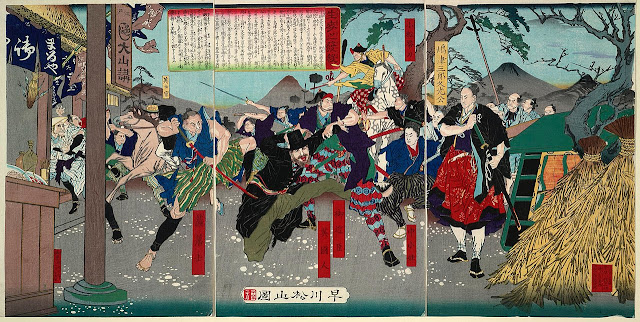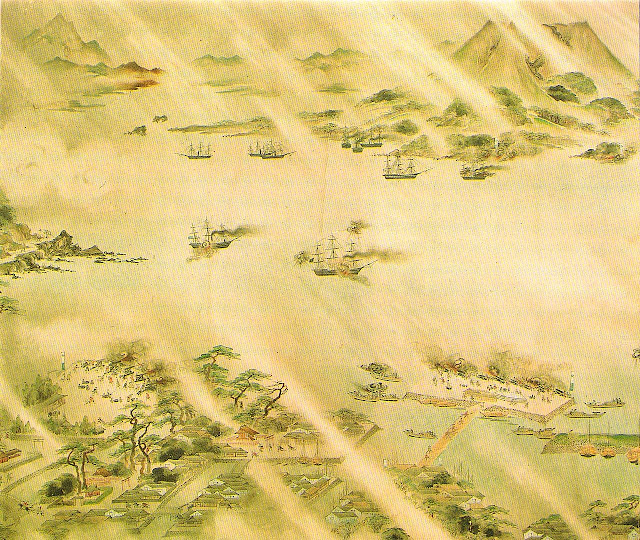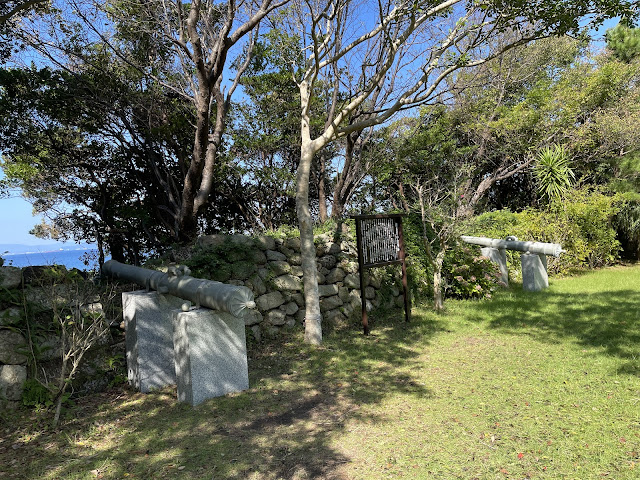
 |
| Namamugi incident, painted by Shozan Hayakawa in 1877 |
In 1862, late Edo period, Satsuma Domain killed one British merchant and hurt 3 fellow British men in Namamugi village, Musashi Province because of violation of Japanese law that no one mustn't block samurais procession. Soon, this incident, so called Namamugi incident, became major problem between Japan, Edo shogunate, and British empire. After some conferences for compensation between the shogunate and the foreign settlement community, Edward St. John Neale, the chargé d'affaires of Great Britain in Japan tried to negotiate for an apology and compensation to Satsuma Domain directly.
In 6th August 1863, Neale departed Yokohama foreign settlement to Kagoshima Bay, coast of the capital of Satsuma Province, with the British squadron composed 7 steam warships, the flagship HMS Euryalus, HMS Pearl, HMS Perseus, HMS Argus, HMS Coquette, HMS Racehorse, and HMS Havock. 5 days later, the squadron anchored at coast 1 kilo meter distance from Kagoshima castle, headquarter of Satsuma Domain. In 14th August, the British squadron send Satsuma Domain to an ultimatum, but Tadayoshi Shimazu, the feudal lord, and his guardian Hisamitsu Shimazu brushed aside it and recognized to be going to open fire.
 |
| A war's situation map from the illustrated London news in 14 November 1863 |
 |
| Some Satsuma's batteries, bombed by the British squadron, and British ships under the gun fire, painting attributed to Ryusatsu Yanagida, patronized Satsuma Domain |
 |
| Captain Josling and Commander Wilmot, killed by Satsuma's coast gun, from the illustrated London news |
In early the following day, as the first attack, British squadron jacked Satsuma's 3 steam warships. Then, the war between British empire, the greatest power in the world, and Satsuma Domain, one of the strongest domains in Japan, was opened fire. After the Royal navy's securing the mastery of Kagoshima Bay and starting bombardment to castle city of Kagoshima, Satsuma started anti-ship battle by coast guns which prepared to British vengeance for Namamugi incident. A part of this war, those gun fire were some effective, the British flag ship was bombed, and her Captain Josling and Commander Wilmot were killed. After intermittent British bombing and Satsuma's anti-ship gun fire, these Satsuma's battery damaged the British flag ship badly, and 2 other ship intermediately. Fleet, in exchange the Royal navy bombed 10 percent of Kagoshima City, destroyed 3 Satsuma Navy's steam ships and 8 coast guns. Thus, both side claimed victory in this "Bombardment of Kagoshima" or "Anglo-Satsuma war", and soon after, both of them made relationship closely for Meiji Restoration. In fact, some key persons, such as Ernest Mason Satow later ambassador of Great Britain in Japan, Heihachiro Togo and Iwao Oyama, later supreme commanders in Russo-Japanese War, were served in this war, and influenced to later British-Japanese relations.
 |
Sea view from Nejimehara battery
(C)JAPAN a while ago |
 |
Inside of the battery, with stone wall and restored guns
(C)JAPAN a while ago |
Because of British squadron and Satsuma Domain focused inner part of Kagoshima Bay, some batteries in mouth of the bay wasn't served in this war. Nejimehara battery in Osumi Peninsula, the Eastern side of mouth of Kagoshima Bay, is one of these. Today, we can see former battery site, containing stone wall length of 60 meters with 2 embrasures, still extant. After the Namamugi incident, Satsuma Domain took about 400 persons for building the battery with a powder house. The battery wasn't used at the war, but it is the last one extant almost completely in these over 24 ones.








